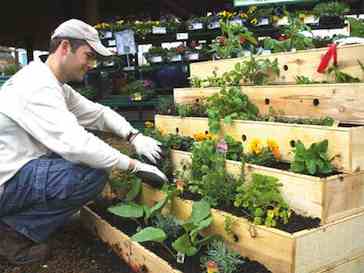
Some people mix edibles with ornamentals, that might seem the permaculture way, but there are advantages to keeping them separate — like its easier, and you can be more focused while looking good too.
Depending on how much space you have, build between one and three raised beds. These measure approximately 90cm by 120cm. Pretty much any receptacle that will drain freely and hold compost will work. There are plenty of books to help you along – here is one example. Raised beds can be made on top of paving if they are deep enough (about 50cm will do). Pots, window boxes, old wooden crates, olive-oil tins and the like can be used, as can the new wave of “pop up” waterproof fabric planters, which have the advantage of being easy to store away for the winter.
Three of them, along with some random pots and some galvanised dustbins, will keep you going quite nicely in fresh salads, herbs and some seasonal veg such as carrots, spring onions, radishes, French beans, spinach, a few salad potatoes, pak choi, blueberries and strawberries. OK, it’s not a fully sustainable existence, but it’s a good start, its fun and financially rewarding all at the same time.
When it comes to choosing what to grow, avoid the slow burners, which take up valuable space for too long such as onions, potatoes and brassicas. Focus on quick, rewarding, easy-to-grow veggies.
Tips for a good crop
Grow something rewarding fast. Some crops, such as cut-and-come-again mixed salad leaves, can be cropped in as little as 20 days. Keep cropping with a pair of scissors and they’ll keep producing.
Sow little and often Even when growing in a small space, to keep a good succession of produce you should sow a little every two or three weeks or so to avoid gluts and keep produce coming all summer long.
Sow more densely than normally Containers and raised beds can be packed to produce more, and any thinnings taken out can usually be eaten or used as a garnish — it’s called micro-veg in posh restaurants!
Sow direct Choose crops that can be sown direct into the soil once the compost in containers and raised beds has warmed up. This saves all the messing around with seedlings on window sills. But do be ready to cover those tender crops on cold nights until the fear of frosts has completely gone.
Use small seed, such as salads, pak choi and carrots wherever possible. Scatter the seed on to the compost rather than in lines, or direct into pots. Or sub-divide areas of raised beds with string and broadcast sow, then thin the seedlings a bit later.
Once spent sow again If a crop is looking tired or stops producing then rip it up and sow something again. Space is valuable, seed is cheap.
Water religiously and feed occasionally Raised beds and containers will dry out very quickly, so harvest rainwater and keep well watered. Feed occasionally with liquid seaweed or tomato food.
Crop regularly Any cut-and-come-again plants such as salad, spinach beans and peas should be cropped regularly to keep them producing more and to stop them to going to seed.
What to grow now
Carrots
Carrots like an easy root run, so light, fertile soils and containers are ideal. Sow from now onwards, then thin to about 8-10cm apart.
Pak choi
Grow in a similar way to salad leaves. Eat baby leaves/thinnings from about 30 days onwards to leave well-spaced individual plants.
Radishes
The easiest and fastest crop, it is ready in 20-30 days. Sow between other rows.
Salad leaves
When leaves are 10-15cm long, snip off leaving 4-5cm behind. Continue to water well and they will regrow several times.
Salad potatoes
Plant densely into large pots, bins or planters. Keep well watered, especially when the plants come into flower.
French beans
Start off indoors in small pots or wait till it’s warm enough to sow direct. Plant into rich, moist soil and don’t let them dry out.
Strawberries
Buy special strawberry pots or stack pots in a mini tower of ever-decreasing pots and plant around the edges.
Spinach
Grow spinach as a cut-and-come-again crop. Crop the baby leaves for salad and use the mature leaves for cooking.
Blueberries
Grow two different varieties for cross pollination and good crops. Plant in acidic, free-draining soil. Water with rainwater.
2 Responses
Hi, I’ve recently been a lurker close to your blog for a few months. I love this article along with your entire website! Looking forward to reading more!
Two people can fulfill all their radish needs in a very small space. Sow every two weeks and have a perpetual supply. We’re actually moving our radish growing indoors as it’s such an efficient use of space.
Add to this a dedicated space for sprouting and you will have delicious healthy food year round.